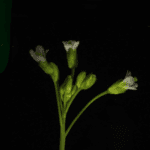Desiccating summer heat brought on by climate change could have adverse effects on Canada’s potato industry. In a recent study published in the journal Botany, researchers examined the heat stress response of 55 potato cultivars to estimate how they might fare under changing climate conditions. What they found spelled bad news: the weight of largest tubers was reduced by 93% on average, and the Russet Burbank—the most common potato used for French fries—was one of the most vulnerable varieties.
“The main processed product of potato is French fries. Approximately 80% of acreage for French fry production in Canada used the cultivar Russet Burbank in 2016,” said study co-author Xiu-Qing Li. “We found that Russet Burbank hardly produces any tubers if temperatures reach 35ºC during the day and 28ºC at night. Therefore, a sharp increase of the number of >30ºC days could have very serious negative impacts on the potato industry, especially the French fry industry.”
Potatoes are one of Canada’s key agricultural products, particularly in New Brunswick and Prince Edward Island where they are the number one commercial crop. However, the tubers are extremely heat sensitive, making them particularly susceptible to warming summer conditions.

The Russet Burbank potato, the cultivar most commonly grown around the world and used for French fries, is extremely susceptible to heat stress.
The ideal temperature for tuber formation in potatoes is between 15ºC and 20ºC, whereas the highest July temperature in most Canadian provinces the past few years has been around 35ºC. As a result of extreme heat stress in Ontario, the potato yield decreased by over 17% in 2016 compared to the previous year.
To find out how the aboveground and belowground parts of the plant reacted and to get a sense of whether there are cultivars that are more heat tolerant, the researchers grew each cultivar in either a control regime of 22ºC during the day and 18ºC at night or in a heat stress regime of 35ºC during the day and 28ºC at night. All of the plants were watered adequately to avoid water stress.
The results suggest that aboveground, heat stress causes increased leaf chlorophyll content and plant height coupled with decreased leaf size. The effect of heat stress on tuber weight was severe, with the average largest tuber weight reduced by over 93% from 72.17g to 4.76g, and there was no tuber formation at all in several cultivars. Overall, the researchers found that under heat stress, potatoes will have less reduction in weight if the plants are taller with more chlorophyll in the leaves.
A group of five cultivars was found to be the most heat stress tolerant. It included Eramosa, Chieftain, AC Belmont, Caribe, and Cherry Red. Unfortunately, one of the least heat tolerant cultivars turned out to be the Russet Burbank, the top cultivar for production globally. Other common varieties such as Kennebec and Yukon Gold also showed a severe decrease in tuber size.
The researchers hope that this new understanding of how heat stress affects different potato cultivars will help in the selection of material for breeding and for identifying the genetic basis of heat tolerance. The trait is likely controlled by multiple genes and can therefore be expected to be influenced by genotype–environment interactions.
Read the full paper: Physiological and growth responses of potato cultivars to heat stress in Botany.




